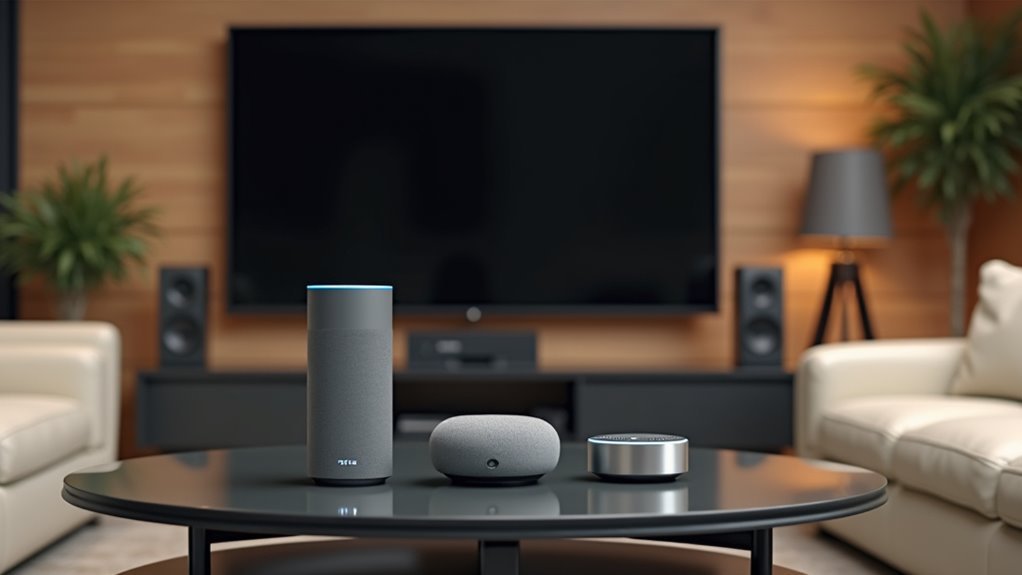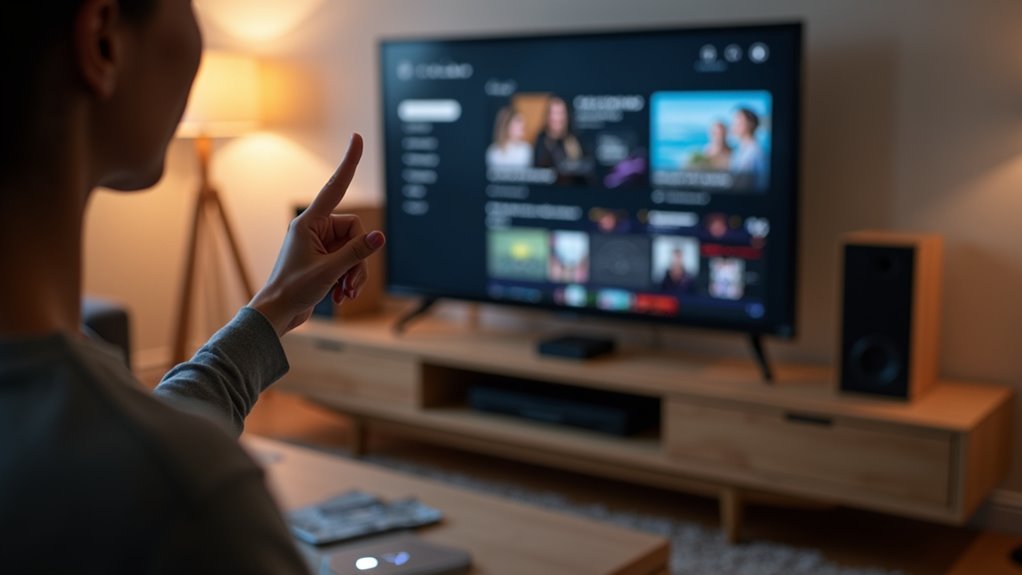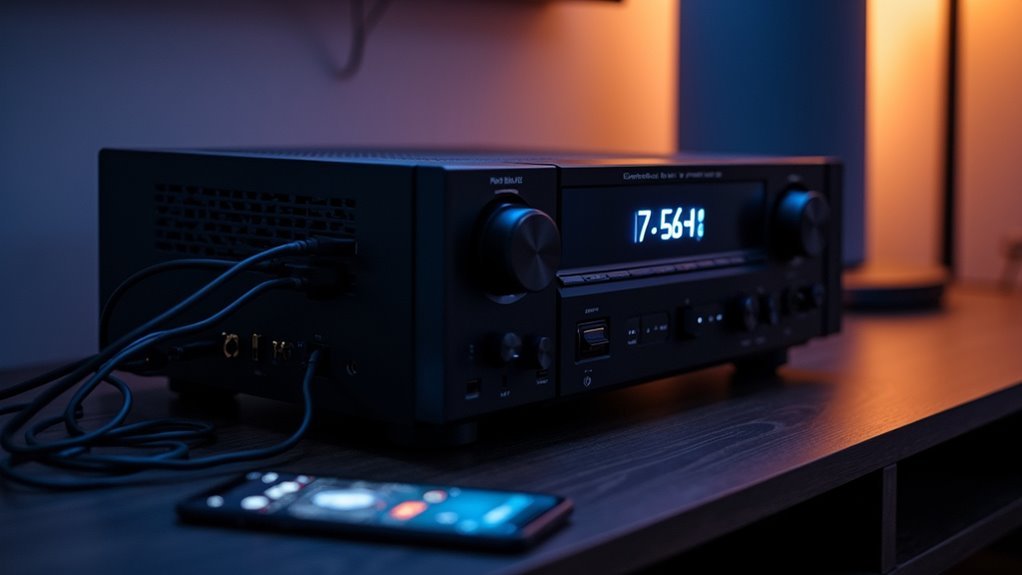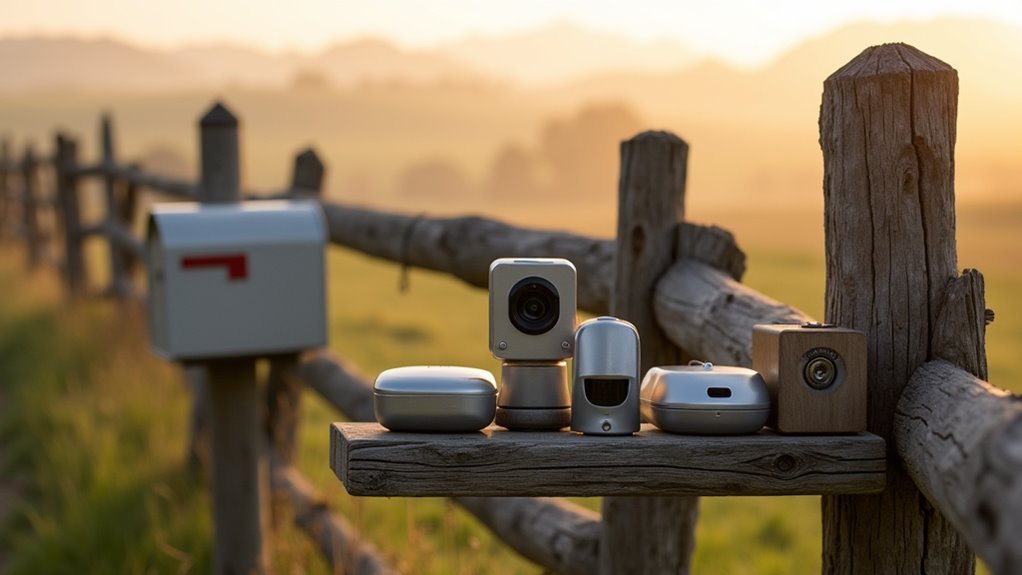You’re probably tired of fumbling for multiple remotes when you want to watch a movie or adjust your sound system. Voice control can transform your home theater into a seamlessly integrated entertainment hub, but there’s a right way and a wrong way to set it up. Most people make critical mistakes during the initial configuration that limit their system’s potential. The difference between amateur voice control and professional-level automation comes down to understanding which components work together and how to optimize them.
Choosing the Right Voice Assistant for Your Setup

Why struggle with multiple remotes when you can control your entire home theater with simple voice commands? Selecting the right voice assistant depends on your existing ecosystem and specific needs.
Amazon Alexa excels for hands-on users who want direct control over compatible receivers, allowing voice commands for playback and sound customization. Google Assistant shines with Chromecast integration, delivering high-resolution audio streaming that greatly enhances your experience. If you’re invested in Apple’s ecosystem, Siri provides seamless Apple Music and AirPlay 2 integration across multiple devices.
Consider your priorities: Do you need multi-room audio support or smart home control? Evaluate compatibility with your current devices and streaming services. Both Alexa and Google Assistant support extensive smart home products, making them versatile choices for thorough theater control.
Essential Equipment for Voice-Controlled Home Theater
You’ll need three core components to build an effective voice-controlled home theater system.
First, select a compatible voice assistant like Amazon Echo or Google Nest that integrates with your existing audio and video equipment.
Next, make certain you have smart speakers or compatible audio components along with robust network infrastructure to support seamless wireless communication between all devices.
Voice Assistant Selection
When selecting a voice assistant for your home theater setup, you’ll need to weigh the strengths of Amazon Alexa, Google Assistant, and Siri against your specific equipment and preferences.
Each platform offers distinct integration capabilities that can make or break your voice control experience. Compatibility becomes essential when connecting existing equipment. Alexa pairs exceptionally well with Sonos systems, while Google Assistant excels with Chromecast-enabled devices.
You’ll want smart speakers with built-in assistants for ideal audio control without extra hardware cluttering your setup.
Consider these emotional benefits of choosing the right assistant:
- Freedom from fumbling with multiple remotes in the dark
- Confidence knowing your commands work flawlessly every time
- Joy from effortlessly impressing guests with seamless voice control
Download your chosen assistant’s app to customize commands and manage connections effectively.
Compatible Audio Components
Three essential audio component categories form the backbone of any voice-controlled home theater system.
First, you’ll need AV receivers with HDMI-CEC functionality, which enables automated device communication and streamlined voice control across your entire setup.
Second, consider powered speakers featuring built-in voice assistants that deliver enhanced sound quality while eliminating additional equipment requirements.
Third, smart soundbars offering Bluetooth or Wi-Fi connectivity provide voice-activated music playback and seamless streaming service integration with platforms like Spotify and Pandora.
When selecting compatible audio components, prioritize equipment that works with popular voice assistants including Amazon Alexa, Google Assistant, or Apple Siri.
Audio distribution systems like Sonos or HEOS by Denon offer multi-room control capabilities, allowing you to manage your entire audio experience through voice commands for truly cohesive listening.
Network Infrastructure Requirements
Before your voice-controlled home theater can deliver the seamless entertainment experience you’re expecting, your network infrastructure must meet specific performance standards.
You’ll need a reliable Wi-Fi network with minimum 25 Mbps speeds to guarantee voice commands respond instantly and streaming remains uninterrupted.
Meeting these network infrastructure requirements transforms your entertainment setup:
- Install a dual-band router – You’ll eliminate frustrating lag by connecting devices across 2.4 GHz and 5 GHz bands, reducing congestion.
- Use Ethernet for stationary devices – You’ll achieve rock-solid stability for streaming boxes and AV receivers versus unreliable Wi-Fi connections.
- Deploy mesh systems in larger homes – You’ll banish dead zones that kill voice control functionality.
Don’t forget to regularly update router firmware and smart device software for peak security and performance.
Setting up Amazon Alexa With Your Audio System
You’ll start by downloading the Amazon Alexa app on your smartphone and connecting your Echo device to your home’s Wi-Fi network.
Next, you’ll physically connect your audio components using the AUX jack on your Echo Dot or guarantee your powered speakers have built-in Alexa compatibility.
Finally, you’ll configure voice commands by enabling music service skills like Spotify or Pandora in the app, allowing seamless voice control of your entire audio system.
Download Alexa App
Getting started with voice control for your home theater begins with downloading the Amazon Alexa app on your smartphone or tablet.
You’ll find this essential app in both the App Store for iOS devices and Google Play Store for Android devices. The download alexa app process is straightforward and free.
Here’s what makes this step exciting:
- Instant access to cutting-edge voice technology that’ll transform your entertainment experience
- Complete control over your audio system without lifting a finger or searching for remotes
- Seamless integration that connects all your smart home devices in one powerful hub
Once you’ve completed the download alexa app installation, you’re ready to create your Amazon account or log into your existing one, setting the foundation for your voice-controlled home theater setup.
Connect Audio Components
Three primary connection methods will link your Alexa device to your audio system, transforming how you control your home theater.
The most straightforward approach involves using the AUX jack on devices like the Echo Dot to create a wired connection between Alexa and your stereo or home theater receiver. This direct connection delivers enhanced sound quality for your entertainment experience.
Alternatively, you can leverage Bluetooth connectivity to wirelessly pair your Alexa device with compatible audio components.
For maximum convenience, consider investing in powered speakers with Alexa built-in, which seamlessly integrate with your existing audio setup without requiring additional connections.
Once connected, you’ll enjoy effortless voice control over your music and entertainment, making your home theater truly responsive to your commands.
Configure Voice Commands
With your Alexa device properly connected to your audio system, the next step involves configuring voice commands to maximize your control capabilities.
You’ll need to set up device discovery and establish specific commands for seamless audio control.
Start by saying “Alexa, discover my devices” so your system can identify all compatible audio components. This guarantees complete integration between Alexa and your setup.
Here are three essential voice commands to configure:
- “Alexa, play [song/artist] on [service]” – Direct music playback from your preferred streaming platform
- “Alexa, set volume to [number]” – Instant audio level control without fumbling for remotes
- “Alexa, switch to [device name]” – Quick changes between different speakers or zones
Regularly update the Alexa app and enable relevant skills to maintain peak voice commands functionality.
Configuring Google Assistant for Home Entertainment
Enhance your setup by linking streaming service accounts such as Spotify and YouTube within the Google Home app for seamless playback.
If you have Chromecast built-in devices, you’ll stream high-resolution audio and video through voice commands without additional remotes.
Create a multi-room audio experience by grouping compatible speakers in the app, then use commands like “Hey Google, play music in the living room” for synchronized sound throughout your home.
Apple Siri and AirPlay Integration

You’ll find Siri’s voice commands transform your Apple home theater setup into a seamless entertainment hub.
Setting up AirPlay 2 across your compatible devices creates a unified audio system that responds instantly to your vocal instructions.
With Apple Music integration, you can control playback, adjust volume levels, and switch between speakers throughout your home without touching a single device.
Siri Voice Commands
Apple’s Siri transforms your home theater into a voice-controlled entertainment hub where you can manage music playback, adjust volume levels, and control device settings without lifting a finger.
Through AirPlay 2, you’ll experience synchronized audio streaming across multiple compatible speakers throughout your home. Your voice becomes the ultimate remote control, letting you request specific songs, playlists, or genres from Apple Music instantly.
Here’s what makes Siri voice commands truly exceptional:
- Effortless Entertainment Control – Command your entire home theater system while relaxing on your couch
- High-Resolution Audio Streaming – Experience crystal-clear sound quality that rivals premium audio systems
- Smart Home Integration – Seamlessly manage lighting, climate, and audio through Apple’s Home app for complete ambiance control
You’ll enjoy superior convenience and sound quality with every spoken request.
AirPlay 2 Setup
Setting up AirPlay 2 transforms your voice commands into a powerful multi-room audio experience that connects your entire home theater ecosystem. You’ll need all devices on the same Wi-Fi network before accessing Control Center to select AirPlay streaming options.
| Device Type | AirPlay 2 Support | Smart Home Control |
|---|---|---|
| Apple TV | Native | Full Siri Integration |
| Sonos Speakers | Compatible | Voice Commands |
| Smart TVs | Select Models | Limited Control |
| HomePod | Native | Complete Integration |
| Third-party Speakers | Varies | Device Dependent |
AirPlay 2’s multi-room capabilities let you group speakers for synchronized playback throughout your home. You’ll control everything directly from your Apple device, eliminating extra remotes while managing audio levels and playbook seamlessly across your expanded entertainment system.
Apple Music Control
Once you’ve established your AirPlay 2 network, Apple Music becomes the centerpiece of your voice-controlled entertainment system.
With Siri at your command, you’ll control your home audio experience effortlessly through simple voice requests. Your personal iTunes libraries and playlists become instantly accessible, transforming how you interact with music throughout your space.
Here’s how Apple Music integration elevates your setup:
- Seamless Multi-Room Streaming – Stream synchronized audio to multiple compatible speakers, filling every corner of your home with crystal-clear sound.
- Hands-Free Playlist Management – Request specific songs, albums, or custom playlists without touching a single device.
- Dynamic Volume Control – Adjust volume levels across different rooms with simple voice commands, creating the perfect ambiance.
The Apple Home app provides intuitive control over device management and speaker selection, making your entertainment system truly intelligent.
Connecting Voice Assistants to Receivers and Speakers

When you’re ready to integrate voice control into your home theater setup, connecting your voice assistant to receivers and speakers becomes the essential first step.
You’ll want to use a wired connection via the AUX jack or optical cable for Amazon Alexa to guarantee enhanced audio control and compatibility with voice commands. Google Assistant pairs seamlessly with compatible wireless speakers and receivers, letting you stream music and control playback effortlessly.
Many powered speakers include built-in voice assistants, providing direct connectivity without extra equipment.
Built-in voice assistants in powered speakers eliminate the need for additional hardware while delivering seamless smart home integration.
You can also leverage HDMI-CEC functionality to simplify setup and control multiple devices through voice commands.
Always verify that your receiver or speaker supports your preferred voice assistant, as compatibility directly impacts available functions.
Multi-Room Audio Control With Voice Commands
You’ll need to establish voice zones throughout your home to enable seamless multi-room audio control with simple spoken commands.
Start by grouping your compatible speakers and devices within your voice assistant’s app, then assign specific room names that you’ll use consistently when issuing commands.
Once you’ve configured these zones, you can sync audio playback across multiple rooms or control individual spaces with targeted voice instructions.
Setting Up Voice Zones
Why settle for controlling just one speaker when you can orchestrate your entire home’s audio experience with simple voice commands?
Setting up voice zones transforms your house into a smart audio paradise where every room responds to your vocal instructions.
First, guarantee all speakers connect to the same Wi-Fi network and are compatible with your chosen voice assistant.
Use your audio system’s app to group speakers by room or zone, enabling synchronized playback or independent control.
Configure each zone with specific names like “living room” or “kitchen” for precise voice commands.
Here’s what you’ll experience:
- Instant mood control – Transform any room’s atmosphere with a single spoken word
- Effortless entertaining – Seamlessly coordinate music throughout your home during parties
- Personal sanctuary creation – Isolate specific zones for intimate listening experiences
Syncing Audio Commands
Once your zones are properly configured, the real magic happens when you start syncing audio commands across multiple rooms simultaneously. You can tell Alexa or Google Assistant to “play jazz in the living room and kitchen” for seamless multi-room control.
Link your streaming services like Spotify or Apple Music to enable effortless playback across connected devices with simple voice commands.
Systems like Sonos and HEOS by Denon let you group speakers together for synchronized audio or control individual rooms separately through intuitive voice interactions.
Chromecast built-in speakers deliver high-resolution streaming that responds to voice commands, creating a dynamic and immersive multi-room experience.
You’ll transform ordinary listening into an orchestrated home-wide audio environment.
Programming Custom Voice Commands and Scenes
While basic voice commands like “turn on the TV” work well for simple tasks, programming custom voice commands and scenes transforms your home theater into a truly personalized entertainment hub.
You can create specific phrases like “Play Movie Night” or “Start Gaming Session” using your voice assistant’s app to trigger multiple actions simultaneously.
Programming scenes lets you group actions together, so saying “Movie Time” dims lights, adjusts temperature, and powers on devices automatically.
Here’s how to maximize your setup:
- Create emotional connections by naming scenes after family activities like “Date Night” or “Kids’ Adventure Time”
- Build anticipation with commands like “Epic Movie Experience” that transform your entire room
- Enhance convenience through third-party platforms like IFTTT for complex, conditional commands
Regularly update commands based on your preferences.
Streaming Service Integration and Voice Control
Beyond basic device control, streaming service integration represents the true power of voice-controlled entertainment systems. You can connect Spotify, Pandora, Netflix, and Hulu directly to your Amazon Alexa or Google Assistant, transforming how you access content.
Simply say “Hey Google, play The Crown on Netflix” to bypass manual navigation entirely.
Your Google Home or Amazon Echo connects to compatible speakers, delivering high-quality audio while you control playback hands-free. Chromecast enables voice control of your TV, letting you command specific shows or movies when your television’s powered on.
You’ll manage multiple services simultaneously, switching from one streaming platform to another with single commands.
Customize voice commands for instant access to preferred content, creating a truly streamlined viewing experience without ever reaching for a remote.
Smart Home Automation for Theater Experience
Voice-controlled streaming represents just one layer of your smart home theater setup.
You can transform your entertainment space into a sophisticated automation hub using platforms like Amazon Alexa or Google Assistant. Voice commands become your gateway to seamless control over lighting, sound, and video systems.
Here’s how smart automation elevates your theater experience:
- Create personalized scenes – Say “movie night” and watch your lights dim while your sound system activates automatically.
- Execute one-button macros – Use apps like Logitech Harmony Hub to control multiple devices with single commands.
- Leverage HDMI-CEC technology – Enable automatic input switching and device communication for effortless operation.
You’ll enjoy hands-free control that adapts to your preferences, making every viewing session feel like a premium theater experience.
Troubleshooting Common Voice Control Issues
Even the most sophisticated voice control systems can encounter hiccups that disrupt your seamless theater experience. When voice commands aren’t working properly, start with basic connectivity checks.
| Issue | Cause | Solution |
|---|---|---|
| Commands not recognized | Unclear phrasing | Rephrase using specific commands |
| Device won’t respond | Connectivity problems | Check Wi-Fi network connection |
| Wrong device activated | Group misconfiguration | Verify speaker grouping in app |
Ensure your voice control device connects to the same Wi-Fi network as your theater components. Regularly update software for both your voice assistant and connected devices, as outdated firmware causes compatibility issues. Enable additional skills in your assistant’s app to improve command understanding. For multi-room setups, properly configure speaker groups to prevent targeting wrong devices.
Privacy Settings and Security Considerations
While voice-controlled home theaters offer incredible convenience, they also raise legitimate concerns about data collection and household privacy. You can take control by adjusting privacy settings in your voice assistant’s app and regularly reviewing what data gets collected.
Here are three essential steps to protect your family’s privacy:
- Use physical mute buttons – Your Google Nest Mini’s mute switch instantly disables listening capabilities when you need complete privacy.
- Disable voice recording features – Turn off data storage in your assistant’s privacy settings to prevent conversations from being saved.
- Secure your home network – Update router passwords and enable WPA3 encryption to block unauthorized access to your devices.
Don’t forget to review your privacy settings monthly to maintain ideal protection.
Advanced Voice Control Features and Customization
Once you’ve secured your voice-controlled setup, you’ll discover that customization transforms your home theater from a basic entertainment system into a personalized command center.
Advanced voice control features let you tailor commands to match your preferences, creating an intuitive experience that responds exactly how you want.
Integration with Amazon Alexa and Google Assistant enables simultaneous device control through custom routines. You can create complex macro commands using systems like Logitech Harmony Hub, where saying “movie night” automatically turns on your TV and launches Netflix.
Streaming compatibility with Spotify and Apple Music provides seamless audio control without remotes.
Regular app updates guarantee your advanced voice control features stay current, continuously adding new functionalities that enhance your home theater’s user interface and overall performance.
Optimizing Voice Recognition and Response Accuracy
The most sophisticated voice control setup won’t deliver ideal performance without fine-tuning your system’s recognition capabilities.
Strategic optimization transforms your home theater from occasionally responsive to consistently reliable.
Here’s how to maximize your voice commands accuracy:
- Position your device strategically – Place it away from speakers and electronics in a central location where your voice reaches the microphone clearly without competing with audio interference.
- Train your system personally – Use voice training features to teach your assistant your unique speech patterns, accent, and pronunciation preferences for dramatically improved recognition.
- Create routine commands – Set up phrases like “Movie Night” that execute multiple actions simultaneously, reducing individual command failures while streamlining your entertainment experience.
Regular software updates guarantee you’re benefiting from the latest recognition improvements.
Frequently Asked Questions
How Can I Make My Home Theater Sound Better?
Invest in high-quality speakers like Sonos, optimize their placement angles, add acoustic panels to reduce echo, upgrade to a Dolby Atmos receiver, and use lossless streaming services for superior audio fidelity.
Is Voice Control Always Listening?
You’ll find voice control devices are always listening for their wake word, but you can mute them using physical buttons. You’re able to manage recordings and adjust privacy settings through the app.
What Is the Best Way to Setup a Home Theater?
Start with a quality AV receiver supporting multiple inputs and streaming services. Add multi-room audio like Sonos, use HDMI-CEC for device communication, install universal remote apps, and guarantee strong Wi-Fi connectivity.
How Do I Connect Alexa to My Home Theater?
You’ll need to download the Amazon Alexa app and connect your Alexa device to the same Wi-Fi network as your home theater system, then enable compatible skills for voice control.





Leave a Reply